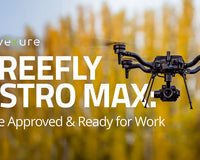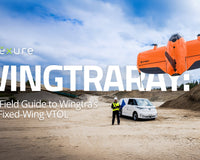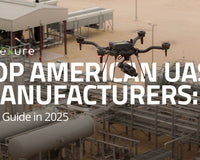When a natural disaster strikes—whether it’s a hurricane, tornado, earthquake, or flood—it leaves communities devastated, destroying homes, infrastructure, and livelihoods. Families lose shelter, businesses are forced to shutter, and entire neighborhoods are upended. The road to recovery is long and arduous, often requiring months or years of effort from governments, contractors, and emergency responders. With disasters increasing in frequency and intensity, the demands on relief teams have never been higher.
It’s in this landscape of destruction and rebuilding that UAS is an invaluable ally. From data collection to real-time damage assessments, drone mapping is transforming the way government, state agencies and departments, and emergency management teams respond to natural disasters—helping communities rebuild faster and smarter.

Mapping the Path to Recovery
In the aftermath, assessing the extent of the damage is one of the most critical tasks. The faster and more accurately this can be done, the quicker recovery efforts can begin.
Drone mapping supports all phases of the disaster management cycle, not just in the immediate response and recovery stages but also in preemptive efforts to reduce disaster risk and readiness for potential threats. Let’s explore how drone technology enhances each phase, starting with prevention.
The Four Phases of Disaster Management:
- Reduction (Prevention)
- Creating Baseline Data Models: Before disaster strikes, drone mapping can be used to create baseline models that help cities plan and prepare. This data informs city planners on how to better design infrastructure, mitigate risk, and reduce the impact of future disasters.
- Readiness (Preparedness)
- ‘Before’ State Mapping: Just before a disaster, drones can be used to map areas in detail, creating a "before" snapshot that can be used for comparison after the event to detect changes and damage.
- Response (Emergency Response)
- Real-Time Damage Assessment: After a disaster, drones equipped with high-resolution sensors quickly assess damage, allowing emergency teams to prioritize aid and safely navigate affected areas.
- Navigational Assistance: Orthomosaics generated from drone data allow emergency teams to determine safe navigation paths for bringing in first responders and resources. These maps also help set up communication networks and classify damage severity to ensure the most critical areas receive aid first.
- Recovery (Rebuilding and Rehabilitation)
- Monitoring Recovery Efforts: Recovery from a disaster can take years, and drones are invaluable in tracking progress. By comparing pre-disaster maps with updated aerial data, planners can track recovery progress and assess the effectiveness of rebuilding efforts.

Why Drones Are Reshaping Disaster Response
- Speed and Efficiency: Drones can cover large areas quickly, offering real-time situational awareness. In contrast, traditional ground surveys can take days or even weeks, particularly in regions with difficult access due to floods, landslides, or damaged infrastructure.
- High-Resolution Data: Drone mapping provides high-quality images and 3D models that help in assessing structural damage, planning emergency responses, and expediting relief efforts. For example, during Hurricane Harvey in 2017, drones were used extensively to map flood damage across Houston, enabling faster recovery efforts.
- In-Depth Analysis: Photogrammetry (stitching together aerial images to create accurate geographic representations) enables teams to assess the integrity of damaged buildings and roads. This allows urban planners and contractors to strategize rebuilding efforts and prevent further collapse or injury.
- Integration with GIS: By integrating drone data with Geographic Information Systems (GIS), recovery teams can layer multiple data sources—such as weather forecasts, population density, and infrastructure maps on top of drone-captured imagery. This holistic view supports informed decision-making for both short-term relief and long-term rebuilding.
- Satellite Imagery: While satellites provide wide coverage, they often suffer from delays due to cloud cover or long intervals between image captures. Drones offer more up-to-date, detailed imagery with higher resolution and the ability to fly below cloud cover, ensuring data collection even during inclement weather.
From Flight to Insight: How Drone Mapping Works
Let’s explore the key deliverables and technologies that make drone mapping so effective in post-disaster scenarios.
Core Deliverables
Drone mapping generates several key deliverables that provide actionable insights for contractors, urban planners, and emergency response teams. Each deliverable offers unique advantages and limitations:
Orthomosaics:
- Description: Orthomosaics are high-resolution, 2D maps created by stitching together aerial images. These maps are georeferenced and corrected for distortions, offering a precise, bird’s-eye view of disaster-affected areas.
- Advantages:
- Fast Processing: Orthomosaics can be generated quickly, often within hours, which is critical during disaster response.
- Navigation Assistance: These maps help emergency responders discern navigation paths, set up communication networks, and determine routes for accessing victims or transporting aid.
- Damage Assessment: Orthomosaics allow responders to classify the severity of damage across affected areas, prioritizing efforts where they are most needed.
- Limitations:
- Lack of 3D Measurements: Since they are 2D deliverables, orthomosaics are not ideal for obtaining precise 3D measurements of terrain or structures.
- Non-Geo-referenced Ortho Limitations: Non-geo-referenced orthomosaics, such as those processed with Pix4Dreact, may not provide exact spatial accuracy but are still valuable for rapid response.
Digital Terrain Models (DTMs):
- Description: DTMs represent the bare ground surface without any objects like trees, buildings, or debris. These models are essential for analyzing terrain changes caused by disasters such as floods or landslides.
- Advantages:
- High-Accuracy Terrain Mapping: DTMs provide a detailed understanding of elevation changes, enabling urban planners to assess flood-prone areas and guide infrastructure rebuilding.
- Vegetation Removal: Since DTMs filter out vegetation, they offer a clearer view of the terrain underneath.
- Limitations:
- Processing Time: DTMs require more intensive data processing, which may slow down rapid disaster response but are valuable for long-term recovery efforts.
Point Clouds:
- Description: Point clouds are 3D datasets created by capturing millions of points in space, typically generated using LiDAR or photogrammetry. These models provide highly detailed, 3D representations of the affected areas.
- Advantages:
- 3D Precision: Point clouds offer unparalleled accuracy for measuring distances, volumes, and structural integrity, crucial for post-disaster rebuilding efforts.
- Volumetric Analysis: Point clouds allow contractors to calculate the volume of debris or materials, enabling efficient resource allocation for clean-up and rebuilding.
- Limitations:
- High Processing Requirements: Point clouds require powerful processing tools and hardware, making them less practical for rapid, on-the-ground disaster response but valuable for long-term planning.
Multirotor vs. Fixed-Wing: Choosing the Right Tool
When it comes to drone mapping in disaster relief, the type of drone used can make a significant difference in terms of efficiency, coverage, and the quality of data captured. Both multirotor and fixed-wing drones play essential roles in disaster response, but each comes with its own strengths and limitations. Understanding when to deploy each type is key to optimizing data collection and speeding up recovery efforts.
Multirotor
Multirotors, such as the DJI Matrice 350, DJI Matrice 30, or Mavic 3 Enterprise series, are versatile and widely used for disaster mapping. These drones are especially valuable in situations where precision and maneuverability are critical.
Key Advantages of Multirotors:
- Precision Mapping: Multirotors can hover and maneuver easily in tight or complex spaces, making them ideal for mapping smaller areas or areas with obstacles, such as collapsed buildings, rubble, or debris-filled streets.
- Thermal Capabilities: Equipped with thermal sensors, multirotors are often used in search and rescue operations to detect heat signatures of trapped victims, especially in hard-to-reach areas.
- Real-Time Data Capture: Their agility allows them to quickly capture real-time data in areas where fast deployment is essential.
Limitations of Multirotors:
- Limited Flight Time: Most multirotors have a shorter flight time (typically 20-30 minutes) and a smaller coverage area, which makes them less efficient for mapping large disaster zones.
Fixed-Wing Drones
Fixed-wing drones, like the WingtraOne or AgEagle eBee X, are designed for endurance and large-scale mapping, making them ideal for surveying vast disaster-affected areas efficiently.
Key Advantages of Fixed-Wing Drones:
- Longer Endurance: Fixed-wing drones can fly for hours, covering much larger areas in a single flight compared to multirotors. This makes them highly efficient for mapping large disaster zones such as floodplains, forests, or hurricane-stricken regions.
- Higher Coverage Rates: For example, the WingtraOne can map up to 400 acres per hour, which significantly reduces the time needed to create comprehensive maps of disaster-affected areas.
- Efficient for Geo-Referencing: These drones are ideal for capturing data that needs to be geo-referenced over larger areas, which is particularly useful in post-disaster recovery and planning for rebuilding efforts.
Limitations of Fixed-Wing Drones:
- Less Maneuverable: Fixed-wing drones require a large open space to take off and land, which can be a limitation in densely populated or debris-filled areas. They are not as capable of hovering or capturing detailed images of specific, confined locations.
- More Specialized Training: Piloting fixed-wing drones typically requires more specialized training, and they are often used by more experienced operators.
Sensing Technologies for Mapping
LiDAR Sensors
LiDAR (Light Detection and Ranging) is a powerful technology used for creating high-precision maps of disaster zones. LiDAR sensors work by emitting laser pulses and measuring the time it takes for the light to reflect back from surfaces, which is used to generate a detailed 3D model of the terrain. This is especially useful in areas with complex topography or where debris obstructs traditional methods of assessment.
LiDAR offers several advantages for post-disaster mapping:
- Precision: It can detect small changes in elevation, making it ideal for tracking terrain changes caused by floods, landslides, or earthquakes.
- Vegetation Penetration: Unlike optical sensors, LiDAR can penetrate tree canopies, allowing for the creation of ground-level models even in heavily forested areas.
- Data Richness: LiDAR data provides millions of data points per square meter, offering unparalleled detail in mapping large-scale disaster zones.
RGB Sensors with Mechanical Shutters
RGB mapping sensors with mechanical shutters are widely used in drone mapping for disaster recovery. These sensors capture high-resolution images that are used to create 2D orthomosaic maps and 3D models through photogrammetry techniques.
Mechanical shutters are essential for drone mapping because they:
- Reduce Image Distortion: Unlike rolling shutters, mechanical shutters capture the entire image at once, avoiding the distortion caused by drone movement. This is critical when flying over large areas to ensure consistent, accurate imagery.
- High-Resolution Mapping: RGB sensors produce high-resolution, color-accurate images, which are critical for assessing damage to infrastructure and planning rebuilding efforts.

Mapping Software for Post-Processing
Once the data is captured, it must be processed to create the deliverables described above. Several software platforms play a critical role in transforming raw drone data into actionable insights:
- Best For: Non-geo-referenced datasets; rapid disaster response.
- Advantages:
- Super Fast Processing: Allows responders to generate orthomosaics quickly, often in under an hour.
- No Internet Required: Works offline, making it ideal for disaster zones with compromised infrastructure.
- Simple Interface: Users can easily create annotations and share maps via PDFs.
- Low Processing Power: Does not require high-end hardware, enabling efficient field use.
- Best For: Creating geo-referenced maps, point clouds, and DTMs.
- Advantages:
- Comprehensive Processing: Handles larger datasets and offers advanced outputs like 3D models and DTMs.
- Point Clouds & 3D Models: Ideal for volumetric measurements and terrain analysis.
- Best For: Processing massive datasets.
- Advantages:
- High Scalability: Efficiently handles large, complex projects such as city-wide mapping after major disasters.
- Advanced Outputs: Supports detailed 3D models, DTMs, and complex terrain analyses.
- Best For: Cloud-based processing and real-time collaboration.
- Advantages:
- Quick Processing: DroneDeploy processes large datasets quickly, but it requires a stable internet connection.
- Color-Coding for Volumetrics: Allows teams to set material densities, color-code volumes, and generate detailed reports.
- Real-Time Collaboration: Cloud-based sharing makes it easy for multiple stakeholders to access maps and collaborate.
- Best For: Efficient cloud-based processing and detailed analysis.
- Advantages:
- User-Friendly Interface: Easy-to-use tools for analyzing data and generating reports.
- Large-Scale Mapping: Ideal for contractors working on city-wide or multi-region disaster recovery projects.
- Best For: Basic, budget-friendly mapping needs.
- Advantages:
- Cost-Effective: Suitable for smaller projects where advanced features like 3D modeling are not required.
- Easy-to-Use Interface: Streamlined workflow for creating orthomosaics and basic maps.

Turning Data Into Action
Once drone mapping data is collected and processed, the insights drawn from it are vital for orchestrating effective disaster relief and rebuilding efforts. The deliverables, such as detailed maps, volumetric models, and real-time data, directly benefit contractors and urban planners by turning complex data into actionable insights. Here's how this processed information translates to real-world advantages:
Mapping Victim Rescue Zones
One of the critical applications of drone mapping in disaster scenarios is identifying areas where victims may be trapped. High-resolution maps generated by LiDAR and RGB sensors enable rescue teams to pinpoint structural collapses, identify blocked roads, and assess areas that are inaccessible by foot. The precision of these maps allows contractors working alongside emergency response teams to prioritize clearing debris, while urban planners can coordinate rescue efforts by focusing on the most critical areas.
Volumetrics and Damage Assessment for Rebuilding
In the aftermath of a disaster, contractors need accurate measurements of debris and materials to plan effective clean-up and rebuilding operations. Drone mapping offers volumetric analysis, which measures the amount of debris or materials that need removal or reconstruction. By analyzing these metrics, contractors can calculate labor, material costs, and the timeframe for rebuilding efforts.
Infrastructure Mapping for Long-Term Planning
Beyond immediate relief efforts, drone mapping plays a crucial role in the strategic rebuilding of communities. Post-disaster planners and contractors must focus not only on recovery but also on strengthening infrastructure to withstand future disasters. Drones equipped with LiDAR sensors offer high-accuracy terrain mapping, which helps urban planners redesign infrastructure like roads, bridges, and utilities. These insights also guide contractors in making informed decisions about where to build or reinforce structures.
Budgeting and Resource Allocation
For both contractors and urban planners, effective resource allocation is a key component of disaster relief and rebuilding. Drone-generated maps provide precise, real-time data that allows planners to allocate labor, machinery, and materials more efficiently. Rather than relying on manual ground surveys, planners can leverage drone data to make faster, more informed decisions, saving both time and money.
Rebuilding Smarter & Faster
Drone mapping has proven to be a transformative tool in disaster recovery, offering fast, detailed data for both immediate relief efforts and long-term rebuilding strategies. Whether it's mapping rescue zones, assessing damage for FEMA funding, or aiding in urban planning for future disaster resilience, the value of the data collected is undeniable.
Through advanced deliverables like orthomosaics, digital terrain models, and point clouds, contractors, emergency response agencies, and urban planners are equipped with the information they need to make swift, informed decisions that can save lives and rebuild communities faster.
For expert guidance on integrating drone solutions into your disaster response efforts, reach out to our team today.










